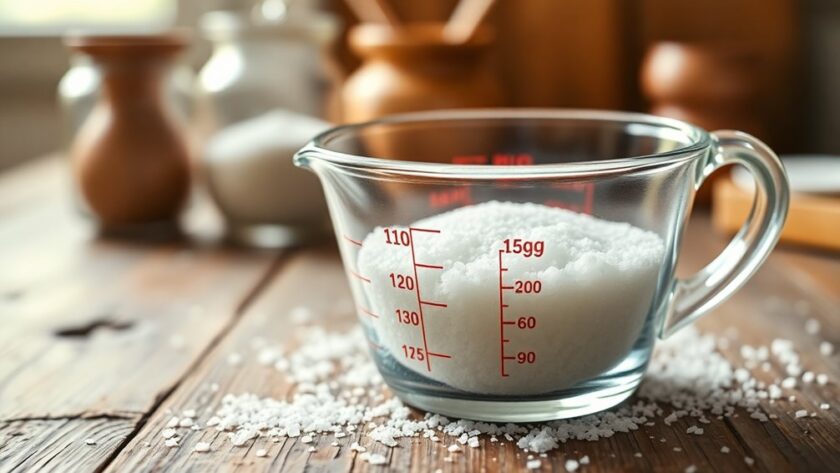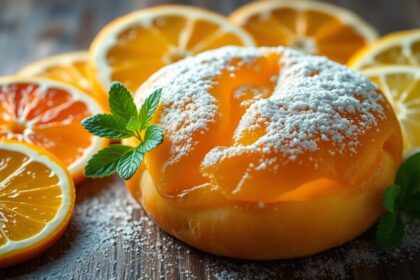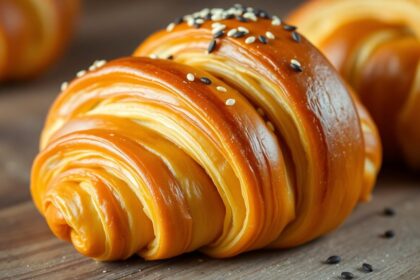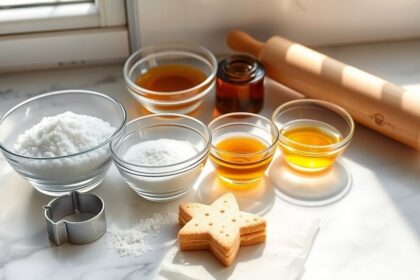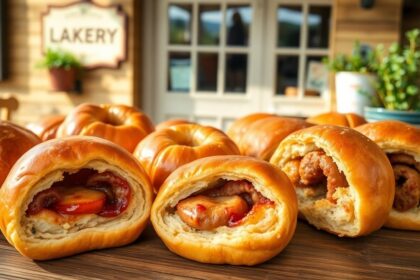When converting 150 grams into cups, it's important to take into account the ingredient. For all-purpose flour, 150 grams is about 1.2 cups, while granulated sugar equates to roughly 0.75 cups. If you're measuring butter, 150 grams is around 0.66 cups. Accurately measuring ingredients can make all the difference in your baking results. Stick around to discover more handy measurement conversions for different ingredients and improve your cooking skills!
Understanding Measurement Conversions
When you're cooking or baking, understanding measurement conversions is essential, especially since different ingredients can weigh differently.
For instance, 150 grams of all-purpose flour translates to about 1.2 cups, while granulated sugar converts to approximately 0.75 cups. Each ingredient has its unique conversion factor, which is why it's vital to know these differences. Using a low-sugar alternative can also impact your ingredient measurements, so understanding how to adjust is key. Additionally, incorporating gluten-free flour may require specific measurement adjustments due to its unique properties.
For example, when converting butter, you divide grams by 227 to get cups. Familiarizing yourself with these common conversions not only enhances your recipe consistency but also improves accuracy in your cooking. Additionally, knowing how to measure gluten-free ingredients can be particularly useful for those who follow specific dietary restrictions.
Measuring by weight is often more precise than measuring by volume, allowing you to make quick adjustments when needed. Mastering these conversions will elevate your culinary skills considerably.
Ingredient-Specific Conversions
Different ingredients require specific conversion factors, making it crucial for you to know how to measure them accurately.
When converting cups to grams, keep these key conversions in mind:
- All-purpose flour: 150 grams equals about 1.2 cups (1 cup + 2 tablespoons). Proper ingredient selection is essential for achieving the desired texture and flavor in your baked goods. Additionally, using almond flour can significantly alter the flavor profile of your recipes, especially in desserts like Kransekake.
- Granulated sugar: 150 grams is roughly 0.75 cups (3/4 cup). Using the right apple varieties can enhance the overall taste of your pie.
- Butter: 150 grams translates to approximately 0.66 cups (2/3 cup).
- Ground almonds: 150 grams is close to 1.5 cups, while whole almonds measure around 0.67 cups.
Knowing these conversions helps you guarantee your recipes turn out just right. Accurate measurements lead to successful cooking and baking, so keep this handy as you switch from cups to grams!
Practical Cooking Tips
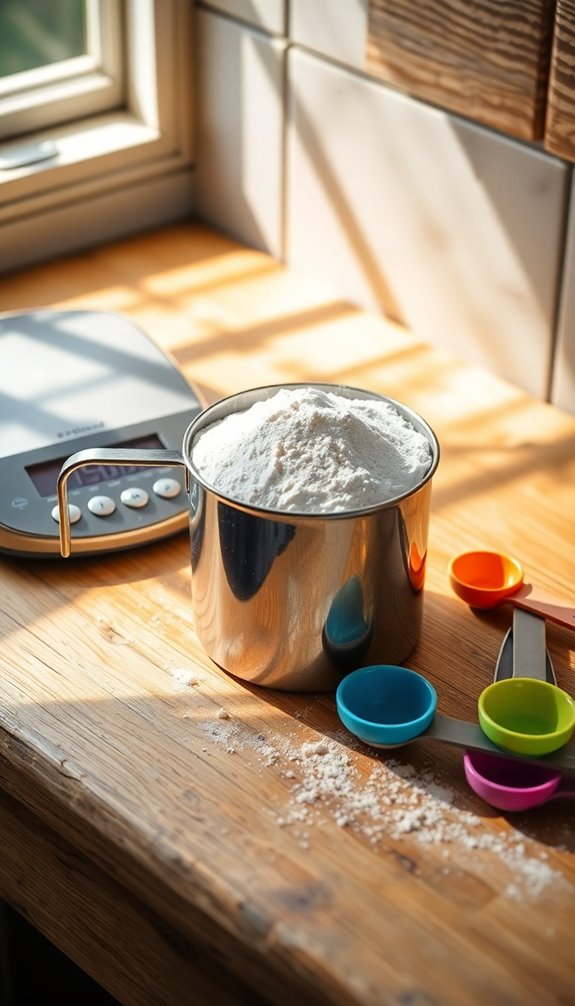
When you measure ingredients, accuracy is key to successful cooking and baking. You might face common conversion challenges, especially when switching from grams to cups. Understanding the importance of using the right fat can also impact the outcome of your baked goods. Additionally, incorporating high-protein ingredients can enhance the nutritional value of your recipes, making them more suitable for athletes and active lifestyles. For instance, using peanut butter bread as a base can provide a deliciously dense and nutritious option for various snacks or meals.
Accurate Ingredient Measurements
Accurate ingredient measurements are essential for achieving the perfect balance in your recipes. Different ingredients have varying densities, making it vital to know how weight converts to volume.
Here are some practical tips to enhance your cooking:
- Use a digital scale for precise measurements instead of relying on volume.
- Familiarize yourself with specific conversion rates, like 1 cup of butter equaling 227 grams.
- Keep charts for commonly used ingredients handy in your kitchen for quick reference.
- Remember that 150 grams of all-purpose flour is about 1.2 cups, while granulated sugar is roughly 0.75 cups.
Common Conversion Challenges
While converting weights to volumes, you might encounter several challenges that can affect your cooking results. Different ingredients have varying densities, meaning 150 grams of all-purpose flour converts to about 1.2 cups, while the same weight of granulated sugar equals roughly 0.75 cups.
To avoid inaccuracies, measuring by weight is often better than volume. The dip and sweep method can lead to using 10-15% more flour than you intended. A digital scale guarantees precise measurements, especially when dealing with conversions.
Familiarizing yourself with specific conversion factors, like 150 grams of butter equating to about 0.66 cups, can simplify your cooking. Keep a handy conversion chart to save time and reduce confusion during your cooking adventures.
Common Ingredients and Their Conversions
When it comes to baking, knowing how to convert common ingredients can save you time and guarantee accuracy. For instance, 150 grams of flour translates to about 1.2 cups, while granulated sugar measures out to 0.75 cups. Understanding these conversions, especially for butter and other ingredients, makes your cooking process smoother and more precise. Additionally, using accurate ingredient measurements is crucial for achieving the best results in cake baking. Incorporating healthier ingredient swaps can also enhance the nutritional profile of your baked goods. For example, using nutty undertones from almond extract can elevate the flavor of your cookies.
Flour Conversion Techniques
Converting ingredients like flour into cups can be tricky, especially since different substances have unique densities.
Using a measuring cup accurately guarantees your recipes turn out perfectly. Here are some key conversions for common types of flour:
- All-purpose flour: 150 grams is approximately 1.2 cups (1 cup + 2 tablespoons).
- Cake flour: 150 grams translates to about 1.2 cups unsifted.
- Bread flour: While not mentioned, it typically measures similarly to all-purpose.
- Sifted flour: If you sift before measuring, the volume increases, so adjust accordingly.
Sugar Measurement Variations
Understanding sugar measurement variations is vital for achieving the right balance in your recipes. For instance, 150 grams of granulated sugar converts to about 0.75 cups. This conversion is essential for precise baking measurements, ensuring you get the texture and flavor you desire.
When it comes to brown sugar, remember that 150 grams also equals roughly 0.75 cups, but it needs to be packed for accuracy. Confectioners' sugar, however, is different; 150 grams is approximately 1.25 cups.
Knowing that 1 cup of granulated or brown sugar typically weighs around 200 grams can simplify your conversions. Accurate sugar measurements can greatly affect your baked goods, so always measure carefully!
Butter Weight Equivalents
Accurate measurements are just as important for butter as they're for sugar in your baking.
When it comes to butter weight equivalents, knowing the conversions can make a big difference. Here are some handy conversions to keep in mind:
- 150 grams of butter is about 0.66 cups (or roughly 2/3 of a cup).
- For precision, 150 grams equals 5.3 ounces.
- 1 cup of butter weighs 227 grams.
- Salted or unsalted butter doesn't change the weight but does affect flavor.
Weighing butter instead of using volume measurements guarantees more accurate results in your recipes.
Flour Conversions: Grams to Cups
When you're baking, knowing how to convert grams of flour to cups can make a big difference in your results.
For instance, 150 grams of all-purpose flour is about 1.2 cups, which is 1 cup plus 2 tablespoons. If you're using cake flour, that same 150 grams translates to roughly 1.5 cups when sifted. Using nutrient-rich flours can enhance the health benefits of your baked goods, as they often contain higher fiber content that promotes improved digestion and sustained energy levels.
However, with bread flour, 150 grams equals about 1.1 cups. Remember, flour density can affect these conversions, so weighing your ingredients is often more accurate than measuring by volume. Additionally, understanding the importance of high-quality ingredients can greatly enhance your baking success.
Also, be cautious with the dip and sweep method, as it can increase the weight by up to 15%, leading to potential measurement adjustments for your baking success.
Sugar Conversions: Grams to Cups
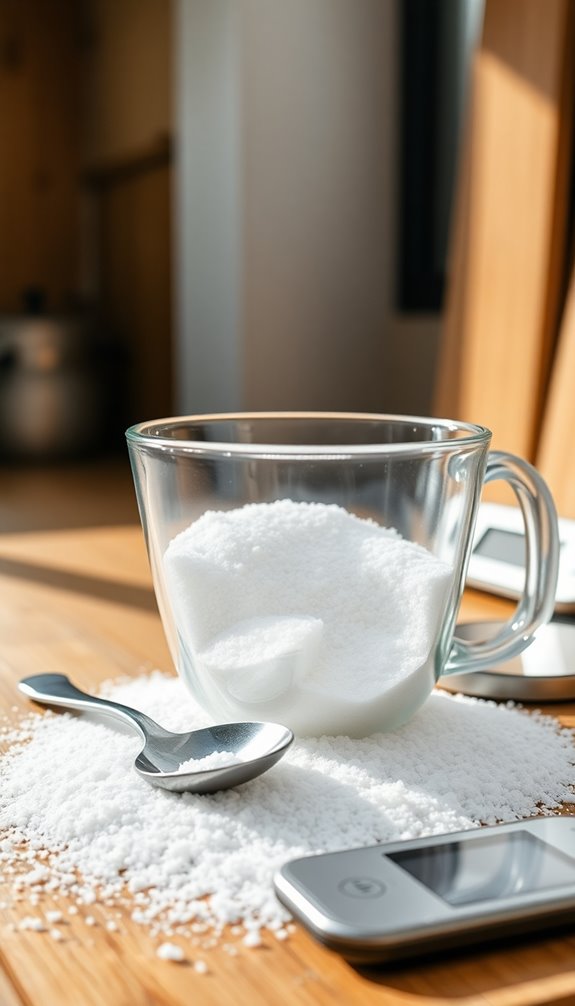
Although baking recipes often list ingredients by volume, converting grams of sugar to cups is essential for achieving the right sweetness and texture in your dishes.
Here's a quick guide for sugar conversions: grams to cups:
- Granulated Sugar: 150 grams equals approximately 0.75 cups (3/4 cup).
- Packed Brown Sugar: 150 grams also converts to about 0.75 cups when measured tightly.
- Confectioners' Sugar: 150 grams weighs less and translates to around 1.25 cups due to its fine texture.
- Accuracy Tip: For best results, use a scale instead of volume measurements, as different types of sugar have varying densities.
Understanding these sugar conversions: grams to cups will help you perfect your baking!
Butter Conversions: Grams to Cups
Converting 150 grams of butter to cups is simple and essential for your baking success. In this case, 150 grams of butter is approximately 0.66 cups, or about two-thirds of a cup.
If you prefer working with ounces, that's roughly 5.3 ounces. For quick butter conversions: grams to cups, remember that 1 cup of butter weighs 227 grams.
So, 150 grams is just a bit more than one stick of butter, which weighs 113 grams. If you want precision in your recipes, using a kitchen scale to measure butter in grams guarantees accuracy, helping you achieve the perfect texture and flavor in your baked goods.
Happy baking!
Liquid Ingredients Conversions
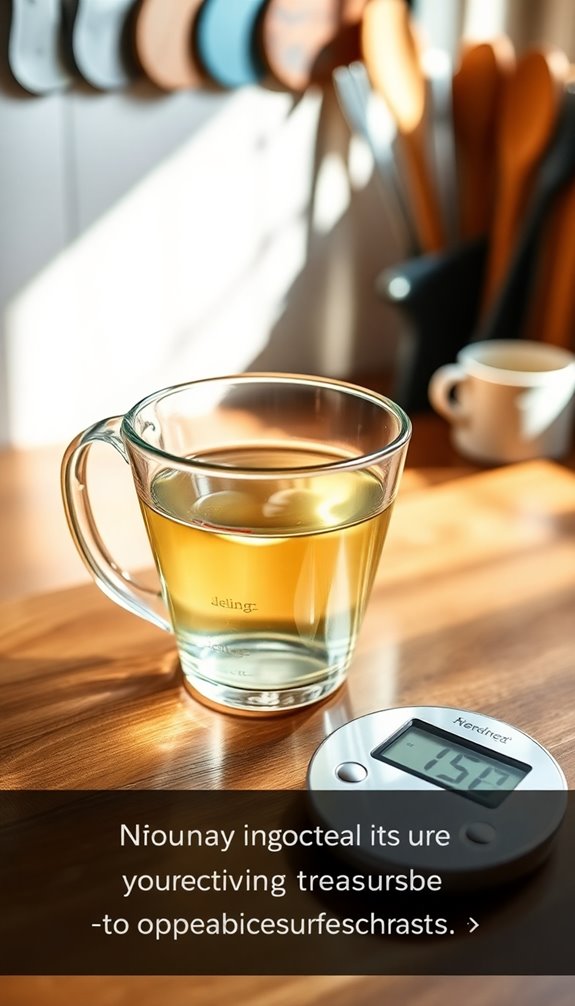
Understanding how to convert liquid ingredients from grams to cups is essential for accurate measurements in cooking and baking.
For effective liquid ingredients conversions, keep these conversions in mind:
- Water: 150 grams = approximately 0.63 cups (or about 3/5 cup).
- Honey: 150 grams = about 0.46 cups.
- Maple Syrup: 150 grams = approximately 0.67 cups.
- Molasses: 150 grams = around 0.46 cups.
When using conversion charts, remember that each liquid has a unique density, affecting the weight per volume.
Knowing these variations helps guarantee your recipes turn out perfectly every time.
Importance of Accurate Measurements
Accurate measurements are essential in cooking and baking, as minor discrepancies can lead to disappointing results.
When you're baking, even slight variations can greatly affect the texture and flavor of your dish. Using weight measurements like grams is often more reliable than volume measurements in US cups, which can fluctuate based on ingredient density.
For instance, 150 grams of all-purpose flour converts to about 1.2 cups, while 150 grams of granulated sugar equals roughly 0.75 cups. By familiarizing yourself with these ingredient-specific conversions, you enhance your recipe reliability.
This precision helps guarantee that you can replicate successful outcomes every time, making your baking adventures more enjoyable and rewarding. Trust the numbers, and your creations will shine!
Conclusion
Whether you're baking a cake or whipping up a savory sauce, accurate measurements can make or break your dish. Converting 150 grams into cups might seem trivial, but it's the difference between a dense loaf and a light, fluffy masterpiece. Embrace these conversions, and you'll navigate your kitchen with ease. Remember, precision is your ally in cooking; a little knowledge goes a long way, transforming simple ingredients into culinary delights that impress every time.

